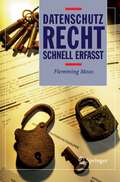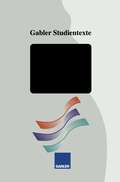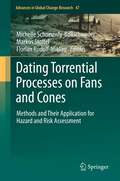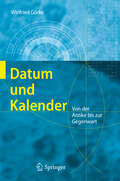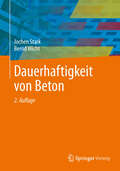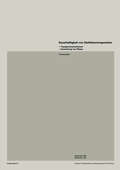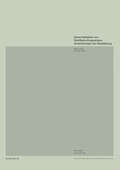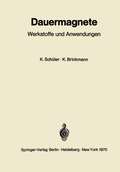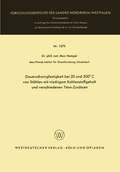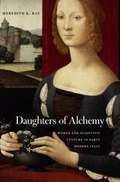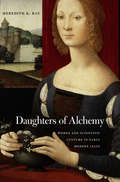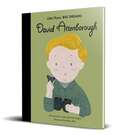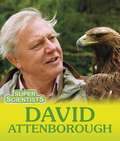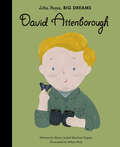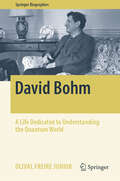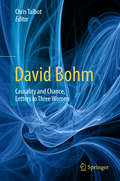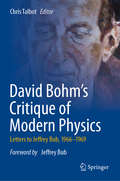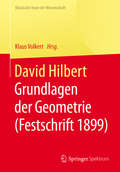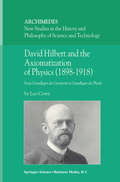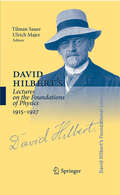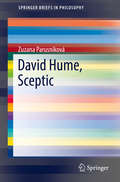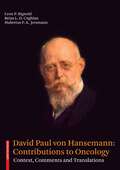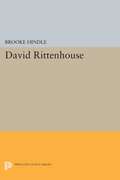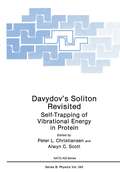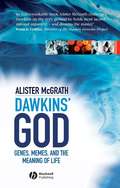- Table View
- List View
Datenschutzrecht - Schnell erfasst (Recht - schnell erfasst)
by Flemming MoosDas Buch ermöglicht eine schnelle aber gleichwohl fundierte Einarbeitung in das Datenschutzrecht. Es ist insbesondere an Rechtsanwälte, Datenschutzbeauftragte und andere Praktiker sowie Studierende gerichtet, die sich erstmals vertieft mit dem Datenschutzrecht beschäftigen. In einer kurzen Einführung werden die Ziele, die Historie und die Rechtsquellen des Datenschutzrechts sowie der Anwendungsbereich der datenschutzrechtlichen Vorschriften erläutert. Im Anschluss daran erfolgt eine Darstellung der zentralen datenschutzrechtlichen Grundsätze, wie etwa des Zweckbindungsgrundsatzes etc. Weitere Kapitel beschäftigen sich ausführlich mit den Anforderungen an die Zulässigkeit der Datenverarbeitung und den ergänzenden Verpflichtungen, z.B. auf Unterrichtung, Auskunft etc. Abschließend geht der Autor auf datenschutzrechtliche Besonderheiten in spezifischen Wirtschaftsbereichen ein und erläutert diese eingehend.
Dating Torrential Processes on Fans and Cones: Methods and Their Application for Hazard and Risk Assessment (Advances in Global Change Research #47)
by Michelle Schneuwly-Bollschweiler, Markus Stoffel and Florian Rudolf-MiklauThis book provides a detailed overview on methods used for the dating of past torrential activity on fans and cones and fosters the discussion on the impact of past and potential future climate change on torrential processes. The book has a clear focus on the practical applications of these methods, complemented by case studies. The limits of each dating method in case of excessive natural and human interventions on fans and cones are shown.
Datum und Kalender: Von der Antike bis zur Gegenwart
by Winfried GörkeNach einer Einführung in das Kalenderwesen erläutert der Autor Alternativen zum gregorianischen Kalender. Er präsentiert verschiedene Kalendersysteme wie den europäischen, den japanischen, chinesischen und den jüdischen Kalender und erläutert anhand der Oster-Berechnung die Methoden der Informatik, die für die Festlegung kalenderabhängiger Festtage von Bedeutung sind. Darüber hinaus stellt er eine Reihe von Vorschlägen zur Verbesserung von Kalendern vor.
Dauerhaftigkeit von Beton
by Jochen Stark Bernd WichtDieses Buch befasst sich mit den Größen und Einflüssen, die für die Dauerhaftigkeit des Baustoffs Beton von Bedeutung sind. Zahlreiche Bilder eröffnen praxisorientierte Einblicke in die werkstoffkundlichen Vorgänge. Kenngrößen und Einflussfaktoren auf die Dauerhaftigkeit von Beton – Zement – Carbonatisierung - Sulfatangriff – schädigende Ettringitbildung im erhärteten Beton – Säureangriff – Einwirkung von Chloriden – Alkali-Kieselsäure-Reaktion – Frost- und Frosttausalz-Widerstand.
Dauerhaftigkeit von Stahlbetonwerken: Transportmechanismen — Auswirkung von Rissen (Institut für Baustatik und Konstruktion #184)
by Keller MennDauerhaftigkeit von Stahlbetonwerken; Auswirkungen der Rissbildung (Institut für Baustatik und Konstruktion #160)
by Käser MennDauerschwingfestigkeit bei 20 und 500°C von Stählen mit niedrigem Kohlenstoffgehalt und verschiedenen Titan-Zusätzen (Forschungsberichte des Landes Nordrhein-Westfalen #1379)
by Max HempelDaughters of Alchemy: Women and Scientific Culture in Early Modern Italy (I Tatti studies in Italian Renaissance history #18)
by Meredith K. RayMeredith Ray shows that women were at the vanguard of empirical culture during the Scientific Revolution. They experimented with medicine and alchemy at home and in court, debated cosmological discoveries in salons and academies, and in their writings used their knowledge of natural philosophy to argue for women’s intellectual equality to men.
Daughters of Alchemy: Women and Scientific Culture in Early Modern Italy (I Tatti studies in Italian Renaissance history #18)
by Meredith K. RayMeredith Ray shows that women were at the vanguard of empirical culture during the Scientific Revolution. They experimented with medicine and alchemy at home and in court, debated cosmological discoveries in salons and academies, and in their writings used their knowledge of natural philosophy to argue for women’s intellectual equality to men.
David Attenborough (Little People, BIG DREAMS #34)
by Maria Isabel Sanchez Vegara Mikyo NohIn this book from the critically acclaimed, multimillion-copy bestselling Little People, BIG DREAMS series, discover the life of David Attenborough, the inspiring broadcaster and conservationist. Little David grew up in Leicester on the campus of a university, where his father was a professor. As a child, he spent hours in the science library, collating his own specimens and creating a mini animal museum. When he was old enough to go to university, he studied science and zoology – but what he wanted most of all was to be close to the animals he was studying. So, he started working in television, visiting animals in their natural habitats and telling the world the untold stories of these animals. This moving book features stylish and quirky illustrations and extra facts at the back, including a biographical timeline with historical photos and a detailed profile of the broadcaster's life. Little People, BIG DREAMS is a bestselling series of books and educational games that explore the lives of outstanding people, from designers and artists to scientists and activists. All of them achieved incredible things, yet each began life as a child with a dream. This empowering series offers inspiring messages to children of all ages, in a range of formats. The board books are told in simple sentences, perfect for reading aloud to babies and toddlers. The hardback versions present expanded stories for beginning readers. Boxed gift sets allow you to collect a selection of the books by theme. Paper dolls, learning cards, matching games and other fun learning tools provide even more ways to make the lives of these role models accessible to children. Inspire the next generation of outstanding people who will change the world with Little People, BIG DREAMS!
David Attenborough (Super Scientists)
by Sarah RidleySuper Scientists are first biographies introducing some of the world's great scientists, simply retelling their lives and explaining why their work was vital. Illustrated with archive images and photographs, the chronology of each lifetime is emphasised by a timeline that runs through the book. David Attenborough tells the story of this colourful scientific figure - covering his origins as the son of a Cambridge don through his work in natural history and broadcasting, his famous educational documentaries and his enduring scientific and popular legacy today.
David Attenborough (Little People, BIG DREAMS #34)
by Maria Isabel Sanchez Vegara Mikyo NohIn this book from the critically acclaimed, multimillion-copy bestselling Little People, BIG DREAMS series, discover the life of David Attenborough, the inspiring broadcaster and conservationist. Little David grew up in Leicester on the campus of a university, where his father was a professor. As a child, he spent hours in the science library, collating his own specimens and creating a mini animal museum. When he was old enough to go to university, he studied science and zoology – but what he wanted most of all was to be close to the animals he was studying. So, he started working in television, visiting animals in their natural habitats and telling the world the untold stories of these animals. This moving book features stylish and quirky illustrations and extra facts at the back, including a biographical timeline with historical photos and a detailed profile of the broadcaster's life. Little People, BIG DREAMS is a bestselling series of books and educational games that explore the lives of outstanding people, from designers and artists to scientists and activists. All of them achieved incredible things, yet each began life as a child with a dream. This empowering series offers inspiring messages to children of all ages, in a range of formats. The board books are told in simple sentences, perfect for reading aloud to babies and toddlers. The hardback versions present expanded stories for beginning readers. Boxed gift sets allow you to collect a selection of the books by theme. Paper dolls, learning cards, matching games and other fun learning tools provide even more ways to make the lives of these role models accessible to children. Inspire the next generation of outstanding people who will change the world with Little People, BIG DREAMS!
David Bohm: A Life Dedicated to Understanding the Quantum World (Springer Biographies)
by Olival Freire JuniorThis authoritative biography addresses the life and work of the quantum physicist David Bohm. Although quantum physics is considered the soundest physical theory, its strange and paradoxical features have challenged - and continue to challenge - even the brightest thinkers. David Bohm dedicated his entire life to enhancing our understanding of quantum mysteries, in particular quantum nonlocality. His work took place at the height of the cultural/political upheaval in the 1950's, which led him to become the most notable American scientist to seek exile in the last century. The story of his life is as fascinating as his ideas on the quantum world are appealing.
David Bohm: Causality and Chance, Letters to Three Women
by Chris TalbotThe letters transcribed in this book were written by physicist David Bohm to three close female acquaintances in the period 1950 to 1956. They provide a background to his causal interpretation of quantum mechanics and the Marxist philosophy that inspired his scientific work in quantum theory, probability and statistical mechanics. In his letters, Bohm reveals the ideas that led to his ground breaking book Causality and Chance in Modern Physics. The political arguments as well as the acute personal problems contained in these letters help to give a rounded, human picture of this leading scientist and twentieth century thinker.
David Bohm's Critique of Modern Physics: Letters to Jeffrey Bub, 1966-1969
by Chris TalbotIn the letters contained in this book, David Bohm argues that the dominant formal, mathematical approach in physics is seriously flawed. In the 1950s and 60s, Bohm took a direction unheard of for a professor of theoretical physics: while still researching in physics, working among others with Yakir Aharanov and later Jeffrey Bub, he also spent time studying “metaphysics”—such as Hegel’s dialectics and Indian panpsychism. 50 years on, questions raised about the direction and philosophical assumptions of theoretical physics show that Bohm’s arguments still have contemporary relevance.
David Hilbert: Grundlagen der Geometrie (Festschrift 1899) (Klassische Texte der Wissenschaft)
by Klaus VolkertOriginaltext und historischer und mathematischer Kommentar von Klaus VolkertDavid Hilberts „Festschrift“ Grundlagen der Geometrie“ aus dem Jahre 1899 wurde zu einem der einflussreichsten Texte der Mathematikgeschichte. Wie kein anderes Werk prägte es die Mathematik des 20. Jahrhunderts und ist auch heute noch von größtem Interesse.Aus der Perspektive eines Mathematikhistorikers schildert der Herausgeber die Entwicklung einer Axiomatik der Geometrie, die spätestens mit Euklids „Elemente“ (ca. 300 v. u. Z.) begann und erst durch Hilbert zu einem vollständigen und handhabbaren System geführt wurde. Nach einer ausführlichen Erläuterung des Hilbertschen Textes wird seine Rezeption bis 1905 umfassend dargestellt und daran anschließend viele der von ihm ausgehenden weiteren direkten und indirekten Entwicklungen skizziert.Die Faszination des Textes ist auch dem heutigen Leser direkt zugänglich, da Hilbert´s axiomatischer Ansatz ohne mengentheoretische Argumente oder formale Logik auskommt.
David Hilbert and the Axiomatization of Physics: From Grundlagen der Geometrie to Grundlagen der Physik (Archimedes #10)
by L. CorryDavid Hilbert (1862-1943) was the most influential mathematician of the early twentieth century and, together with Henri Poincaré, the last mathematical universalist. His main known areas of research and influence were in pure mathematics (algebra, number theory, geometry, integral equations and analysis, logic and foundations), but he was also known to have some interest in physical topics. The latter, however, was traditionally conceived as comprising only sporadic incursions into a scientific domain which was essentially foreign to his mainstream of activity and in which he only made scattered, if important, contributions. Based on an extensive use of mainly unpublished archival sources, the present book presents a totally fresh and comprehensive picture of Hilbert’s intense, original, well-informed, and highly influential involvement with physics, that spanned his entire career and that constituted a truly main focus of interest in his scientific horizon. His program for axiomatizing physical theories provides the connecting link with his research in more purely mathematical fields, especially geometry, and a unifying point of view from which to understand his physical activities in general. In particular, the now famous dialogue and interaction between Hilbert and Einstein, leading to the formulation in 1915 of the generally covariant field-equations of gravitation, is adequately explored here within the natural context of Hilbert’s overall scientific world-view. This book will be of interest to historians of physics and of mathematics, to historically-minded physicists and mathematicians, and to philosophers of science.
David Hilbert's Lectures on the Foundations of Physics 1915-1927: Relativity, Quantum Theory and Epistemology
by Arne Schirrmacher Heinz-Jürgen SchmidtThese documents do nothing less than bear witness to one of the most dramatic changes in the foundations of science. The book has three sections that cover general relativity, epistemological issues, and quantum mechanics. This fascinating work will be a vital text for historians and philosophers of physics, as well as researchers in related physical theories.
David Hume, Sceptic (SpringerBriefs in Philosophy)
by Zuzana ParusnikováThis book studies Hume’s scepticism and its roots, context, and role in the philosopher’s life. It relates how Hume wrote his philosophy in a time of tumult, as the millennia-old metaphysical tradition that placed humans and their cognitive abilities in an ontological framework collapsed and gave way to one that placed the autonomy of the individual in its center. It then discusses the birth of modernity that Descartes inaugurated and Kant completed with his Copernican revolution that moved philosophy from Being to the Self. It shows how modernity gave rise to a new kind of scepticism, involving doubt not just about the adequacy of our knowledge but about the very existence of a world independent of the self. The book then examines how Hume faced the sceptical implications and how his empiricism added yet another sceptical theme with the main question being how argument can legitimize key concepts of human understanding instinctively used in making sense of our perceptions. Placing it firmly in a historical context, the book shows how Hume was influenced by Pyrrhonian scepticism and how this becomes clear in Hume’s acceptance of the weakness of reason and in his emphasis on the practical role of philosophy. As the book argues, rather than serving as the foundation of science, in Hume’s hand, philosophy became a guide to a joyful, happy life, to a documentary of common life and to moderately educated, entertaining conversation. This way Hume stands in strong opposition to the (early) modern mainstream.
David Paul von Hansemann: Context, Comments and Translations
by Leon P. Bignold Brian L. Coghlan Hubertus P.A. JersmannIn the late nineteenth century, David Paul von Hansemann coined phrases that have remained the basis of descriptive terms concerning the microscopical appearances of tumors ever since, yet his work is rarely mentioned today. This book presents translations of all the relevant German texts and analyses the background and context of Hansemann's theories. It shows that some of Hansemann’s ideas may still be relevant to cancer research today.
David Rittenhouse (PDF)
by Brooke HindleOne of the great figures of the American Enlightenment, David Rittenhouse of Pennsylvania rose from his work as a mechanic and clockmaker of exquisite craftsmanship to informed, careful astronomy and effective experimental work in optics, magnetism, and psychology. This book shows how he applied his scientific ability to public projects and, eventually, to the establishment of a 'national mint', and how he used his increasing prestige to further crucial political objectives of the time. This man, considered a brilliant scientist by Franklin and Jefferson, was, according to Benjamin Rush, "one of the luminaries of the eighteenth century."Originally published in 1964.The Princeton Legacy Library uses the latest print-on-demand technology to again make available previously out-of-print books from the distinguished backlist of Princeton University Press. These editions preserve the original texts of these important books while presenting them in durable paperback and hardcover editions. The goal of the Princeton Legacy Library is to vastly increase access to the rich scholarly heritage found in the thousands of books published by Princeton University Press since its founding in 1905.
Davydov’s Soliton Revisited: Self-Trapping of Vibrational Energy in Protein (Nato Science Series B: #243)
by Peter L. Christiansen Alwyn C. ScottProceedings of a NATO ARW held in Thisted, Denmark, July 30-August 5, 1989
Dawkins' GOD: Genes, Memes, and the Meaning of Life
by Alister E. McGrathAlister E. McGrath is one of the world’s leading theologians, with a doctorate in the sciences. Richard Dawkins is one of the bestselling popular science writers, with outspoken and controversial views on religion. This fascinating and provoking work is the first book-length response to Dawkins’ ideas, and offers an ideal introduction to the topical issues of science and religion. Addresses fundamental questions about Dawkins’ approach to science and religion: Is the gene actually selfish? Is the blind watchmaker a suitable analogy? Are there other ways of looking at things? Tackles Dawkins’ hostile and controversial views on religion, and examines the religious implications of his scientific ideas, making for a fascinating and provoking debate Written in a very engaging and accessible style, ideal to those approaching scientific and religious issues for the first time Alister McGrath is uniquely qualified to write this book. He is one of the world’s best known and most respected theologians, with a strong research background in molecular biophysics A superb book by one of the world’s leading theologians, which will attract wide interest in the growing popular science market, similar to Susan Blackmore’s The Meme Machine (1999).
